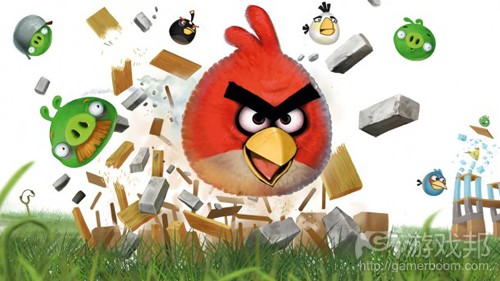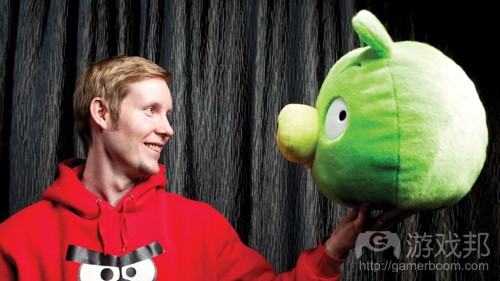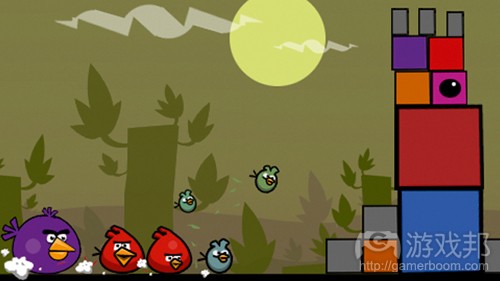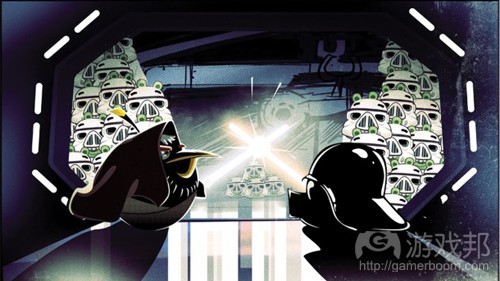Rovio高管回顾《愤怒的小鸟》诞生过程
《愤怒的小鸟》是一个令人瞩目的现象。该系列已经成为游戏行业的一个形象大使,它是一款足以令非游戏玩家在上下班途中打发时间,已经入驻成千上万名主机游戏玩家的移动设备的游戏。
尽管这一切有部分原因要归功于在其之前诞生的无数类似物理Flash游戏,但Rovio空前的成功绝非仅仅源于在正确的时间进入苹果App Store。它的成功秘诀难以捉摸,但直观的控制方式,令人满意的弹力物理机制,以及远超同类竞争者的润色水准当然也是其中关键因素。在其所有的元素中,最大的贡献当属设计师Jaakko lisalo新颖的设计,它不但催活了整款游戏,而且还从小小的手机屏幕走向更大的空间(例如装饰便当盒等周边产品),甚至赢得了LucasArts的青睐。
Rovio联合创始人Niklas Hed表示,“没错,《愤怒的小鸟:星球大战》对卢斯卡影业来说是一个巨大的垫脚石”。若是其他公司发表这种言论,或许会被认为是一种吹嘘,但《愤怒的小鸟》系列销量已经达到17亿份,这为Rovio赢得了骄傲的资本。lisalo勾画首批愤怒的小鸟草图时,Rovio与今天这个成功神话之间简直是天差地别。
早在2009年,该工作室仍在承接其他公司的外包工作,人员规模也从50人缩减至12人。他们在一个大型外包项目中投入超过一年时间,最后却只等来了项目被取消的结果,当时的Rovio亟需一个热作支撑公司的发展。
这也是一个机会,这剩余的12名成员商量着创造自己的作品。
Hed回忆道,“对我来说,那段时间就像是休眠,我们挑了一些项目,打算借鉴他们的做法。我们制作了大量原型,例如在游戏中使用手机的电子罗盘等功能。通过那段时间,我们深深认识到技术该如何与游戏自然结合。”
这家公司之前已经有50款游戏作铺垫,所以他们最不缺的就是开发经验。但这次,该团队打算以不同的方式执行创意过程,计划创造一个不仅仅局限于单款游戏的品牌。他们希望尽量让这款游戏虏获广泛的用户,并抓住触屏智能手机人气不断增长的机遇,但却并不明确如何执行。
“我们已经创造了不少游戏,但由于当时的商业和行业形势,我们还真看不出自己能做什么,我们曾想过制作基于焦土策略(游戏邦注:例如军队撤退时销毁一切敌军可利用之物)式的弹道坦克游戏。”
Rovio当时已经看到物理谜题游戏在休闲领域的兴起,但认为军事装备并不具有他们所追求的大众吸引力。
lisalo表示,“我开始制作并向管理层描述游戏理念,《愤怒的小鸟》只是这些理念之一。大家当时并不太理解我所提出的早期游戏机制,但它的角色设计(一群愤怒的小鸟粉碎建筑结构)却赢得了大家的喜爱。
尝试了不同理念之后,我们终于发现了合适的游戏风格并开始投入制作。当然,此时我们也意识到了小鸟需要一个敌人……”
对于外人来说,病态的绿色小猪并非一个显而易见的选择,但lisalo打小就开始画小猪。因此用他的内在逻辑来说,这些小鸟的报仇对象就是小猪。但该游戏的其他元素并没有因为这种抽象概念而成形。例如,游戏原先并没有直观的弹弓,小鸟一开始也并不是在弹弓上射出,而是让玩家点触小鸟沿着他们所划动的方向发射。这听起来很简单,但该团队很快意识到,他们所瞄准的休闲群体并不具有那种内在的游戏直觉,他们需要更多辅助元素。
弹弓再加上支撑游戏的强力物理机制貌似更为直观。尽管其物理机制引发了Wired等媒体对其背后数学原理的分析,但准确模拟却并非Rovio最大的担忧。Rovio游戏副总裁Tuomo Lehtinen表示,“这背后有个基本的数学原理,但我们没必要去深究,因为这并没有多大意义,最重要的还是感觉”。《愤怒的小鸟》至少是尊重了物理法则。
据Hed所称,“《愤怒的小鸟》后来成了整个工作室最心爱的项目。整个核心团队很小,但人人都在为其投入精力。我们喜欢制作这款游戏,它真正激发了我们的自信——我们自己都爱玩这款游戏,我们有一种即将迎来新纪元的预感。”
但为这个早期原型润色花了相当长的时间,大家的工作也曾因缺乏资源一度遭遇障碍。框架团队同时要处理多个项目,所以必须从中分散注意力。Lehtinen称“这在一定程度上拖延了《愤怒的小鸟》项目进程,毕竟那时设计师在创建关卡,而程序员却在忙于为另一个项目编写引擎!”Rovio为这个项目设定的初始预算很快就耗尽了,这几乎导致整个项目被取消。
Hed称“早期的结果并不如意。要让这个游戏世界——让草地、石头、冰块等元素显得真实,实在是一个艰巨的挑战。小鸟的弹射还是很不自然,其中材料感觉并不合适。”
但这种停歇不乏益处,让整个团队得以腾出时间迭代游戏玩法和技术。
Lehtinen对此解释道,“如果你玩了足够长的时间,就会开始发现哪些元素会让你不快。我几乎是在最后一天制作时才迭代摄像机的控制方式。这是需要优化的地方,它必须呈现很棒的感觉。我认为这款游戏如此受欢迎的一个原因就是它根本不会让你困扰。我们能够消除所有不对劲的地方。”
今天玩《愤怒的小鸟》的体验与2009年该游戏首次上线时极为不同。这款游戏的迭代从未间断,通过经常更新而消除游戏中令人不快的元素。但其核心玩法仍然保持不变。
该游戏初始版本发布时,Roivo很不安。Hed坦言,“我们发布游戏时,觉得它不过是诸多游戏中平凡的一者。我真的觉得《愤怒的小鸟》是我们做过的最佳游戏,但还是隐隐觉得它还有一些不足。我们在半年之前做了一些市场调查,总觉得它缺乏市场营销。”
“在那之前,我们一直是与移动运营商打交道,从来没有直接同用户打照面,现在我们已经进入App Store这个竞争激烈的市场,要获得大量粉丝非常之难,如果你不能处理好这个环节,再好的游戏也无济于事。但最终,我们还是追上大流,这款游戏甚至还成了用户购买智能手机的原因之一。”
在过去数年,Rovio一直推出不同版本的游戏。首个衍生版本是《愤怒的小鸟》节日版,也是Rovio计划已久的一个版本。最初在2010年10月发布的是《愤怒的小鸟:万圣节》,之后是含有圣诞节关卡的版本。节日版本现在包含了各种各样的假日主题,甚至还有中秋节版内容。这种广泛的文化覆盖面正是Rovio游戏获得大众吸引力的一个明证。但在其简单的表象之下则隐藏着一个更为艰巨的挑战。人们很容易将Rovio视为昙花一现,只是推出同款游戏的不同版本,但节日版本却是以相似的外表呈现全新的游戏挑战。
2011年3月问世的《愤怒的小鸟:里约》是该公司力图突破翻新游戏这种模式的又一举措。该游戏与20世纪福克斯动画片《里约大冒险》进行捆绑营销合作,引进了新敌人、动画背景、新小鸟、斗牛犬Luiz,甚至还含有boss战斗元素。它还采用了新物理引擎,据Rovio数据显示,这款游戏甚为独特,它甚至拥有一大批仅玩这个版本的粉丝。作为电影的营销工具,它的表现也同样不赖,在美国的民调显示,有不少电影观众是通过这款游戏了解了这部电影。
但与最初游戏模版差距最大的当属《愤怒的小鸟:星球大战》,由于重力下降等因素,小鸟飞翔过程会延长。正如第一个版本,它也差点夭折。
Hed承认“我们觉得它的第一个原型实在太难了,决定放弃这个项目。但Jaakko还是坚持改进原型,我记得当我们看到重新设计的玩法之后,突然觉得一切都有意义了。”
Lehtinen解释称,“我们花了大量时间把它简化成我们想要的样子。一开始,它的感觉非常地硬核——太空和科幻是黑暗主题,玩家几乎可以随处射击。这是最难搬上正轨的游戏。”
但这种科幻设定让Rovio思索:是否可以参照《愤怒的小鸟:里约》的品牌植入合作模式?Rovio为此联系了包括LucasArts在内的许多公司,试图找到令该游戏理念可行的方法。LucasArts对此很感兴趣——它在移动领域相对缺乏影响力,而Rovio美术人员所提供的概念草图也清楚表明这种植入合作绝非拙劣的模仿。Rovio同一向谨慎的LucasArts由此在相互尊重的前提下达成了合作。
《愤怒的小鸟:星球大战》制作人Mikko Häkkinen表示,“坦白说,我一度担忧LucasArt苛刻的审核流程和品牌方针是否会令此事受阻,但最终一切事情都比预期更为顺利。我们同对方公司的一些了解《愤怒的小鸟》IP重要性,并愿意尊重我们意愿和观点的杰出人才共同完成了任务。”
“他们为我们提供了相关知识和信息,并提出了一些匹配不同角色和故事要点的绝妙想法。”
与原版不一样的是,大家对《愤怒的小鸟:星球大战》的兴趣远超预期,Rovio公司的许多《星球大战》粉丝几乎人人都想参与这个项目,甚至不吝于贡献自己的闲暇时间。Häkkinen笑称“大家提交了大量精美的图像资产,以至于我们难以挑选出最佳作品和风格。”
这款游戏也在Roivo及其玩家中创造了一批新粉丝,也吸引了一些仍未接触《愤怒的小鸟》的用户。Hed自嘲道,《愤怒的小鸟:星球大战》仅抓住了该授权品牌的表面元素,Rovio与LucasArts之间的关系将有何进展则要取决于双方的进一步合作,以及一些保密协议。但无论下一步将走向何处,《愤怒的小鸟》从未停止步伐——它已经走向PC、社交网络,甚至是PS3/360平台,并且毫无减缓之势。但Rovio在品牌植入领域会停步于《星球大战》这个顶峰吗?
Häkkinen再度自嘲称“Rovio有个老笑话是将小鸟、猪与太空超人宇宙结合起来,但你应该不会想看到肌肉结实的小鸟这种概念艺术。”(本文为游戏邦/gamerboom.com编译,拒绝任何不保留版权的转载,如需转载请联系:游戏邦)
The Making Of: Angry Birds
Angry Birds is a feathered phenomenon. Rovio’s series serves as an envoy for the game industry, an app that people who don’t play games will happily while away their commuting hours with, but one that has also found a home on the phones of thousands of console gamers.
While it must credit its core design to the countless similar physics-based Flash games that preceded it, Rovio’s unprecedented success was far from simply a case of being in the App Store at the right time. The secret to its success is hard to pin down, but intuitive controls, satisfyingly bouncy physics and a level of polish far beyond many of its peers certainly helped. Of all its ingredients, perhaps it owes most to designer Jaakko Iisalo’s crisp designs, which proved appealing enough not only to inspire an entire game, but also move beyond the small screen to the big one, adorn lunchboxes, and even earn the trust of the famously protective LucasArts.
“Yeah, Angry Birds Star Wars was a huge stepping stone,” says co-founder Niklas Hed, pausing just a beat before delivering his punchline, “for LucasFilm.” From any other company, a comment like that might seem a touch bullish, but the Angry Birds series has sold 1.7 billion copies across its lifetime, which earns Rovio the right to puff out its chest feathers now and again. When Iisalo sketched those first infuriated birds, however, Rovio was far from the success story that it is today.
In early 2009, the studio was still doing subcontracting work for other companies and had downsized from 50 people to just 12. Having spent more than a year on a big contract, only to have it cancelled through no fault of its own, Rovio was in desperate need of a hit. This was an opportunity, those remaining 12 reasoned, to create something all their own.
“For me, that time was sort of a hibernation,” says Hed. “We took only selected projects and aimed to learn from them. We did a lot of prototyping, such as using the electronic compass of phones in games. That time taught us how technology is combined with games in a natural way, and how it isn’t.”
Rovio co-founder Niklas Hed.
And with over 50 games already under its belt, the studio hardly lacked experience. But this time, the team decided to approach the creative process differently, aiming to create a brand that could span more than just a single game. It knew it wanted to appeal to as broad an audience as possible, and to take advantage of the growing popularity of touchscreen-enabled smartphones, but exactly how wasn’t yet clear.
“We had already created several games, but because of the business and the environment back then, we really couldn’t see what we were able to do,” says Hed. “We’d been thinking about a ballistic tank game in the vein of Scorched Earth.”
Rovio had recognised the growing popularity of physics-based puzzlers in the casual space, but at the time decided military equipment didn’t have the mass appeal it was looking for.
“I started creating game concepts and pitching them to the management. Angry Birds was one of these concepts,” Iisalo says. “People didn’t really get the early game mechanics I suggested, but the character design was something that everybody liked: an angry flock of birds smashing through structures. After dozens of different ideas, we found the right style of game and started production. Of course, that’s when we realised the birds needed an opponent…”
Sickly green pigs wouldn’t have been an obvious choice to an outsider, but Iisalo had been sketching swine since childhood. And so through his own internal logic, the birds found their nemeses. Other elements of the game couldn’t get away with such abstraction, however. That intuitive catapult, for example, wasn’t always the mechanism through which the birds were granted flight: the initial version simply had players flick them in the direction they wanted to launch. It sounds simple enough, but the team quickly realised that the casual audience it was attempting to court didn’t share their natural gaming instincts. It needed something more.
One of Jaakko Iisalo’s Angry Birds sketches.
A catapult seemed intuitive, backed by the punchy physics that power the game. But while the physics has even inspired the likes of Wired to have a go at analysing the maths behind it, accurate modelling isn’t Rovio’s biggest concern. “There is basic maths behind it, and we couldn’t have ice breaking rock, because that wouldn’t make sense,” Tuomo Lehtinen, VP of games, tells us of a title that has flightless birds and green pigs, ”but the feel is the most important thing.” Angry Birds respects the laws of physics, then, if not the laws of nature.
“Angry Birds ended up being the pet project of the whole studio,” says Hed. “The core team was small, but everyone was working on it to a degree. We loved doing it. It really kicked our confidence to a whole new level – we loved playing the game ourselves, and there was a definite feeling of things being on a roll again and the beginning of a new era.”
But polishing that early prototype took a long time, and work was hampered by a lack of resources. The skeletal team was working on several projects at once, and so had to divide its attention across them all. “At certain points it was causing delays [to Angry Birds],” says Lehtinen. “It’s really hard for a designer to create levels when the programmer is too busy on another project to finish the engine!” And the initial budget that Rovio had set aside was rapidly depleted, almost causing the development to be cancelled.
“The early results weren’t quite what we wanted,” says Hed. “It was surprisingly challenging to make the game world feel real, make all the blocks feel like glass, stone, ice, and so forth – organic. The birds kept bouncing in an unnatural way and the materials just didn’t feel right.”
All the hold-ups proved beneficial, though, giving the team time to iterate its gameplay and the tech behind it.
“If you play something long enough you start to notice what irritates you,” Lehtinen explains. “I was iterating camera controls almost until the last day of production. That was something that had to be perfect; it had to feel really, really nice. And I think one of the big reasons the game has proved so popular is because it doesn’t annoy you at all. We were able to iron out all of the quirks.”
Well, almost all the quirks. Play Angry Birds today and the experience is markedly different to the one that first launched in 2009. The iterative process on which the game was built has continued throughout its lifetime, resulting in the few clunky elements that did manage to slip by being smoothed off via regular updates. The core of the gameplay, though, remains unchanged.
When that first version launched, though, Rovio was apprehensive. “When we published the game, frankly it felt like was it was just one game among many,” admits Hed. “I definitely felt that Angry Birds was the best game we had ever done, but there was this nagging feeling that it wasn’t enough. We had done some research half a year earlier, and it always seemed to come down to the marketing – or lack of it.
“We had been working through mobile operators without a direct contact to the consumers up until then, and now we were entering the App Store, where the competition was really hard. Getting the critical mass of fans was really difficult, and if you can’t manage to do that, it doesn’t matter how good the game is. But in the end, we managed to catch the wave and it became one of the reasons why you should get a smartphone.”
Over the years, Rovio has toyed with the format. Its first major deviation was Seasons, a release Rovio had been planning for a long time. Originally released as Angry Birds Halloween in October 2010, and closely followed by a selection of Christmas levels, Seasons now includes all manner of holiday-themed stages, even one based on the relatively obscure Chinese Mid-Autumn Festival. Such wide-reaching cultural references are demonstrative of the broad appeal of Rovio’s games, but underneath its inoffensive exterior lies a much harder game. It’s easy to dismiss Rovio as a kind of one-hit wonder, trading on multiple variations of the same game, but Seasons was a brand-new challenge presented in a familiar skin.
And Angry Birds Rio, which followed in March 2011, was further evidence of a company unwilling to rely on simply rehashing past successes. Being a tie-in with 20th Century Fox’s animated film about exotic bird smuggling helped the game introduce new enemies, animated backgrounds, new birds, an ally in the form of bulldog Luiz, and even boss fights. It featured a new physics engine as well and, according to Rovio’s figures, is unique among the series in having a large following who only play that version. As marketing for the film, it didn’t do badly either: exit polls in the US revealed that the majority of moviegoers heard about it through the game.
But it was Angry Birds Space that deviated furthest from that initial template, gifting the birds prolonged flying time as gravity was dialled down. And, just like the first game, it almost didn’t happen.
“We felt that the first prototype was way too hard, and decided not to continue with it,” admits Hed. “But Jaakko [Iisalo] kept polishing it, and I remember one session we saw the redesigned gameplay and all of a sudden it made sense.”
“It took a lot of time to make it as simple as we wanted,” explains Lehtinen. “At first, it felt really hardcore: space and sci-fi are dark themes, and the player could shoot essentially anywhere. It was the hardest game to make right.”
But that sci-fi excursion got the studio thinking: what if there was a tie-in opportunity to be found along the lines of Rio? Rovio approached a number of companies, including LucasArts, with its idea, trying to get a feel for what would be required to make it happen. LucasArts was interested – it lacked a high-profile mobile presence, and the concept sketches Rovio’s artists had put together made it clear that this tie-in would be far from a half-hearted parody. Rovio and the notoriously protective LucasArts found a mutual respect in the careful way each handled its creations.
“To be honest, I had my worries about how rigid [LucasArt’s] approval process and brand guidelines would be, but in the end everything went much smoother than expected,” says Angry Birds Star Wars producer Mikko Häkkinen. “We worked with some great people who understood how important the Angry Birds IP is for us, and were willing to respect our wishes and viewpoints.
“It ended up being more of a collaboration where they offered us guidance on lore and things, and came up with some great ideas for matching different characters and story points.”
And unlike the original game, Star Wars suffered from an excess of interest, with so many Star Wars fans in the company that almost everyone wanted to work on it – even in their spare time. “We ended up with such a vast amount of graphics assets that it was really hard to choose the best ones and settle on one style,” laughs Häkkinen.
It created new fans, too, both within Rovio and among its players, and just maybe convinced some of those last few hold-outs to give Angry Birds a go – after all, there are few things in life that can’t be made more appealing with the familiar scream of a TIE fighter’s engines. Yet Angry Birds Star Wars only scratches the surface of the licence’s potential and, Hed teases, how far that relationship gets taken is between Rovio and LucasArts. And likely subject to some tight non-disclosure agreements. But whatever happens next, the Angry Birds series has never been in ruder health – it’s already found its way to PC, social networks and even PS3/360, and looks to be in no danger of losing its momentum anytime soon, either. But could Rovio really ever top Star Wars when it comes to tie-ins?
“There is an old joke in Rovio of combining the birds and pigs with the He-Man universe,” Häkkinen teases. “You really don’t want to see the concept art [we] made for those muscular bird heroes in thongs, though.”(source:edge-online)













































